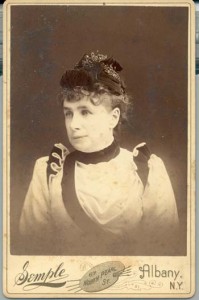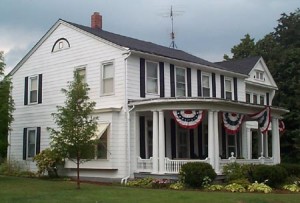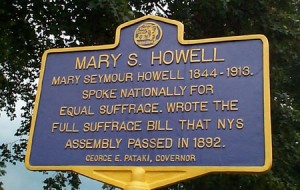 Born 1844
Born 1844
Birthplace Mount Morris, NY
Died February, 1913
Grave Site Mt. Morris, NY
Contribution Women’s rights lecturer and suffrage activist
Mary Seymour was born in Mount Morris (Livingston County), New York, in 1844 to Norman and Frances Metcalf Seymour. Her father, a prominent businessman, was also a public speaker and local historian. She was one of four children.
She taught at the Mt. Morris Academy as a young woman. In 1869, she married George Rogers Howell, of Southampton (Long Island), New York. Upon their marriage the Howells moved to Albany, New York, where Mr. Howell held a position at the State Library. He was later to become the State Librarian. The Howells had one son, George Seymour Howell, who died in 1891 while a student at Harvard University.
Mary Seymour Howell promoted women’s rights and women’s suffrage during her years in Albany. She was acquainted with many legislators and state officials, and used her influence to advocate for women’s causes. She was also a sought-after speaker, giving speeches before legislative bodies in New York State, and traveling as a suffrage lecturer in many states.
In 1890, the National American Woman Suffrage Association (NAWSA) sent Howell into South Dakota as a paid speaker during that state’s campaign for women’s suffrage. In addition to Howell and Susan B. Anthony, other suffrage speakers who worked in South Dakota included Reverend Anna Howard Shaw, Reverend Olympia Brown, and Carrie Chapman Catt. Ida Husted Harper, biographer of Susan B. Anthony, describes the conditions that confronted these suffragists in South Dakota:
Frequently the speakers had to drive twenty miles between the afternoon and evening meetings, in the heat of summer and the chill of late autumn; at one time forty miles on a wagon seat without a back… Several times in the midst of their speeches, the audience was stampeded by cyclones, not a soul left in the house.
Harper relates that at one point during the campaign, Howell and Anthony stayed in a “hotel” where they ate a “supper” of “sour bread, muddy coffee and stewed green grapes” while battling “heat and flies.”
The South Dakota campaign also had its rewards. A celebratory moment occurred at an event on July 10, 1890, when Anthony received a telegram from Washington “saying that President Harrison had signed the bill admitting Wyoming into the Union with woman suffrage in its constitution.” Howell, who shared the stage with Anthony at this event, later recalled the reaction of Anthony and the audience:
Before she [Anthony] could finish reading [the telegram] the great audience was on its feet, cheering and waving handkerchiefs and fans. After the enthusiasm had subsided Miss Anthony made a short but wonderful speech. The very tones of her voice changed; there were ringing notes of gladness and tender ones of thankfulness. It was the first great victory of her forty years of work. She spoke as one inspired, while the audience listened for every word, some cheering, others weeping.
 Susan B. Anthony continued to speak and travel widely as she grew older, but her efforts were increasingly supplemented by younger suffrage speakers, including Howell. In addition to Howell’s work in South Dakota, she also toured Kansas and Idaho in the 1890s, speaking on behalf of women’s suffrage and temperance. On the Kansas tour she was accompanied by the Reverend Anna Shaw and funded, at least in part, by Rachel Foster Avery.
Susan B. Anthony continued to speak and travel widely as she grew older, but her efforts were increasingly supplemented by younger suffrage speakers, including Howell. In addition to Howell’s work in South Dakota, she also toured Kansas and Idaho in the 1890s, speaking on behalf of women’s suffrage and temperance. On the Kansas tour she was accompanied by the Reverend Anna Shaw and funded, at least in part, by Rachel Foster Avery.
Howell’s savvy use of her political connections, as well as her speaking ability, is also in evidence during this period. In 1892, she authored a women’s suffrage bill that passed in the New York State Assembly. An historic marker in the Village of Mt. Morris (in front of 22 State Street) commemorates this activity. And, when one of the trustees of the State Industrial School in Rochester, New York died in the early 1890s, Anthony asked Howell to lobby the governor and urge him to appoint a woman to the post. (One other woman was already serving as trustee.) Howell’s efforts paid off, and Susan B. Anthony herself assumed this position. (Anthony was reappointed to a full term by Governor Levi P. Morton on May 4, 1893.)
During New York State’s 1894 suffrage campaign, Howell spoke at a large number of mass meetings throughout the state. She appeared at a statewide hearing in favor of a suffrage amendment to the New York State Constitution on June 28th of the same year. Two years later, in 1896, she was a speaker at the seventy-sixth birthday celebration for Susan B. Anthony, hosted by the Rochester Political Equality Club.
During the 1890s, Howell suffered a series of personal losses in addition to her son’s death in 1891. On February 21, 1892, her father died. Upon the death of her husband in 1899, she moved from Albany back to Mt. Morris, and lived with her mother until her mother’s death in 1904.
Howell maintained her political connections and continued to advocate for suffrage from her Mt. Morris home until her own death, from pneumonia, in February of 1913. She was buried at the village’s local cemetery.
Bibliography of Suggested Books & Articles
- Appell, Howard W., “Plaque to Honor Women’s Rights Advocate Born in Mt. Morris,” [Mt. Morris?], Clarion, September 17, 1998.
- “Death of Well Known Woman Tuesday Night,” (newspaper article, ?, [1913])
- Harper, Ida Husted, The Life and Work of Susan B. Anthony, v. 2: Indianapolis: Bowen-Merrill Co., 1898.
- Historic Plaque, located in Mt. Morris, NY (1998).
- History of Woman Suffrage, v. IV (New York State Campaign), Anthony, Susan B. and Ida Husted Harper, eds., Rochester, NY: 1902 (Reprint Source Book Press, 1970)